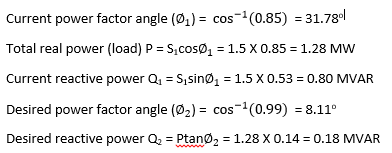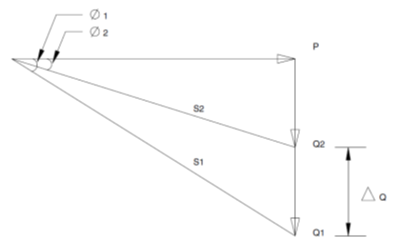What is power factor?
Power Factor (P.F.) can be viewed as the percentage of total apparent power that is converted into real or useful power. Mathematically, we can say that the active power (P)
can be represented as: 
It is also seen as the displacement between the voltage and the current waveforms as shown below:
While the above is typically called as displacement power factor (cosine of angle between the fundamental voltage and current waveforms), presence of harmonics results in waveform distortions and hence result in true power factor being different from displacement power factor.
Appliances usually have motors that result in lagging power factor (current lags the voltage thus resulting in positive Φ). To compensate for this lagging power factor, capacitor banks are put in place that provide leading power factor (current leads the voltage thus resulting in negative Φ).
Power factor compensation: Savings from reduced KVAh consumption
Let us understand power factor compensation by working out an example. Assume that you have a 2 MVA transformer that is loaded on average to 1.5 MVA. Consider your power factor to be 0.85 (this is typically lagging power factor). Let us first calculate the leading KVAR (required from capacitor bank) to correct the power factor to 0.99.


So the capacitor bank should switch on capacitors worth 620 KVAR to compensate the power factor and bring it to 0.99. Following figure illustrates the different power units pictorially.

In India since the commercial consumers are charged at KVAh and now KWh consumption, total savings you will get due to reduced KVA consumption = (1.5 – 1.29) X 1000 X 24 = 5040 KWhr/day
Assuming the commercial unit price of Rs 8, total amount saved due to reduced KVA consumption = 5040 X 8 X 365 = Rs 1.47 crores
Additional reduction due to reduced transformer losses:
Now if the transformer has rated conductor loss of 1% of transformer rating, total energy saved assuming that 1.5 MVA is the operating load can be calculated as follows.
Total energy saved with reduction in transformer losses = 0.41/100 X 2000 X 24 = 196.8 KWhr/day
Assuming a unit price of Rs 8, the total amount saved = 196.8 X 8 X 365 = Rs 5.75 Lakhs.
While the primary saving of Rs 1.47 crores (as calculated above) is what people often quote and calculate, the savings due to reduced percentage loss in transformer is often neglected.
Other advantages of power factor correction:
Besides getting financial benefits, correcting the power factor has several other benefits, including increased equipment life and reduced heating for the equipment. Additionally, the freed up power (1500 – 1290 = 210 KVA) is now available for supply to other consumers.
Selection of capacitor banks:
Large power factor correction capacitors can result in flow of capacitive current eventually resulting in increased voltage. Therefore, careful switching of capacitors is important to not just maintain the right power factor but also for avoiding large voltage fluctuations. Especially, if the demand is heavily varying throughout the day, a fixed set of capacitors always turned on can be damaging. In such cases, a switched capacitor bank, which contains a power factor controller that senses the load and regulates the power factor by switching blocks of capacitors in and out, is worth the investment.
Harmonics and Capacitor Banks:
Capacitor banks are designed to operate at a maximum voltage of 110% of their rated voltage and 135% of their rated KVARs. Large voltage and current harmonics result in ratings getting exceeded and hence significant loss. Reactance of capacitors is inversely proportional to its frequency so high frequency harmonics easily find a low reactance path into the capacitor banks causing overload and subsequent failures. A more serious condition with potential for much larger damage is harmonic resonance which happens when the inductive and the capacitive reactance become equal on one of the harmonic frequencies.
Ref: Power Quality, C Sankaran
